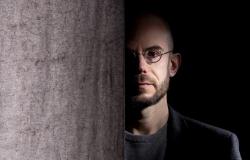The Théâtre national de Strasbourg (TNS) offers an attractive program all year round, but it is also a multidisciplinary school which teaches professions linked to the stage. Each class, to sign off on the end of the three-year course, is invited to build projects from scratch, led by student directors. To get a closer look at all the work that goes behind a performance, but also the little hands in the shadows that we tend to forget, we slipped behind the scenes of Groupe 48 (48th promotion) before two of their performances. We show you.
When we talk about going to see a play at the TNS, we think of the thrill of the audience, the actors under the spotlight, the stage which transforms into an ephemeral universe, or even the wild applause. But to give a performance, it takes weeks of work, then hours of preparation on the big day.
To see more clearly, we followed group 48 for a whole afternoon, to chat with the students about the creation of the projects, see the magic of makeup, costumes and sets, attend the sound and lighting adjustments, the final tests and the adrenaline that precedes the opening clap.
We followed the preparations for two collective creations which were performed the same afternoon at the Grüber space: L’Ellipse Then Time is out of jointrespectively directed by Elsa Revcolevschi and Sarah Cohen. And we loved those bubbling moments.
The Ellipse: initially, a text
From June 20 to 25, two shows were performed in turn in the two rooms of the Grüber space, each directed by TNS students. Because this National Theater has a school within it, which allows students to learn the professions in the field in real conditions.
For both performances, the promotion of group 48 was divided in two. We first sneaked alongside the team working on L’Ellipsed’Elsa Revcolevschi. The starting point for the piece is Match magazine, published between 1938 and 1940.
“I wanted to see how fascism was spread through the tabloid press. In Match, excerpts from Mein Kampf were published alongside articles on wearing corsets or cabarets. As if nothing had happened.”
To realize its ambition, Elsa wrote a text after working with the group during laboratory work in October 2023. “I saw how the actors played, spoke, expressed themselves. And I wrote the text to measure. » And it’s from here that everything starts.
Transforming writing into a living object
This text, worked on with the team, is recited in the sets meticulously designed by Noa Gimenez, who paid attention to the smallest details. While Elsa takes stock with the team, and reads her notes on previous performances, we stroll on stage, decorated in the colors of the 40s. And we let ourselves be carried away by the atmosphere.
We discover a myriad of objects, from the period or not, which interact together like a giant puzzle. Typewriter, telephone booth, old copies of Match magazine, posters and postcards, all with one goal: to create a world that oscillates between a cabaret and press offices.
As we wander through the still lifeless scenery, Macha initiates her light sequences, and Corentin checks the progress of the sounds one last time. Perched at the top of the room, they test the lighting ambiances, launch the cabaret music or the sounds of bombardment. We delight in the snippets of the show, while the actress Blanche warms up on the edge of the stage.
Makeup and chatting: the strength of group projects
We make a small detour via the lodges, where we find Nina doing Aurélie’s hair. We take advantage of this retro blow-dry moment to chat with them. Aurélie explains to us that she wanted to enter the TNS because of the multidisciplinarity of the school.
“There are lots of different sections: acting, dramaturgy, management, direction, or even costume-scenography… All theater professions are represented there. »
And the one who chose the game section develops: “Basically, I am a musician. But I also like to play. With theater, I was able to find a compromise to combine all these desires on stage. At TNS, we were even able to take piano or ukulele lessons to improve our skills. We can make all our desires come true, and all through collective projects. »
This is the same point that Nina emphasizes, in the costume-scenography section: “The diversity of backgrounds allows us to create group projects, using each person’s strengths. We are never alone, we are in constant dialogue.”
Costumes: magic and a good dose of know-how
Nina continues by talking about her experience as a costume designer: “For example, for the Ellipse, I had to research dress codes from the 30s-40s. I worked with the budget and resources of the TNS, and in particular the enormous stock of costumes. But beyond that, you have to take into account the comfort of the actors, whether the clothes fit the decor, and above all, the work on lighting and sound. We are never alone.
And for the galleys, Camille, dresser, is there to support students. « We discuss desires, and I help them achieve them, I answer technical questions, and provide my know-how. I give them a helping hand with alterations, maintenance, outfit changes… We create the automatisms of the job!”
“Time is out of joint”, final preparations
Change of scenery: we pop in to see preparations for Time is out of joint. The show starts in an hour: everyone is agitated, but we manage to chat a little with Sarah Cohen, the director, and Louison Ryser, the playwright. We also wondered what the exact missions of these professions were, which we know little about and which the two young women learned at the TNS school.
Sarah tells us more: “The theatre stage is not the place where I recognize myself the most. I loved everything that came beforehand: the staging, the lighting, the direction of the actors/actresses, the texts… In short, the idea of creating a multifaceted object. And that’s the staging. »
“As for the playwright, we can say that it is the guardian of meaning »adds Louison. “We follow the project, we dialogue with the staging… Our main role is to support the transition from text material to stage, on all levels. And to check that everything remains coherent.”
Create, together and always
Concretely, for Time is out of jointthe show combines three sources: Hamlet by Shakespeare, philosophical texts by Derrida, and the words of the seven actors. All to talk about youth and their struggles in this world that moves fast, too fast and in all directions. An ambitious project, with many facets.
It is this same youth who worked collectively to put together Sarah’s first play. “We built the project from A to Z. What school defends, ultimately, is our freedom to create. We are not here just to execute, but to pass on a little (a lot) of ourselves. And that is a privilege.
Louison continues: “The beauty of the project, is that everyone was able to put their mark on it. Dramaturgy, lights, sounds, sets, texts… We worked with everyone’s ideas to make it a deeply collective object. »
“Curtain up in 20 minutes!” »
The entire show team is busy with the final preparations. Mathis tests the lights one last time, and lights the scene for us so that we can enjoy the bubbling.
Everyone prepares themselves in their own way, in the middle of a parade of vocalizations, determined steps and stretching. Some nervously pace around the stage with their headphones on, others engage in little gymnastics. We work on our approach with heels, we repeat our lines while mumbling, we warm up our voice by singing.
In the middle of these frantic comings and goings, we make the last touch-ups for the makeup, the last adjustments to the microphones. And while the actors nervously pace around the set, Sarah brings them together for the traditional word.
“We are going to do even better. We’re gonna give everything ! » Last hugs, last nervous hugs. The public returns, the lights go out. And the magic happens.






